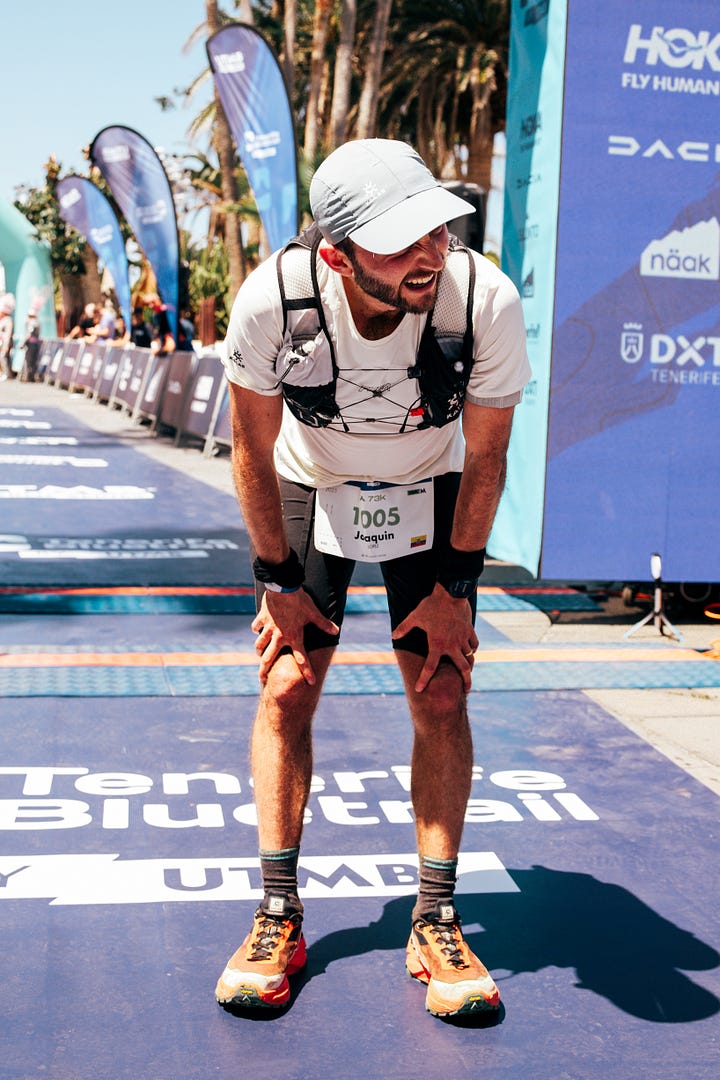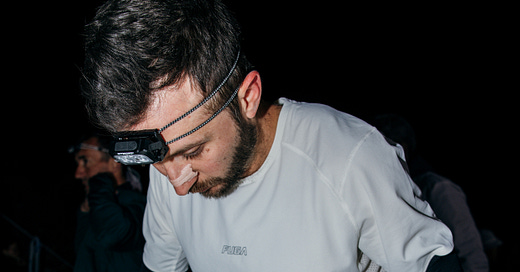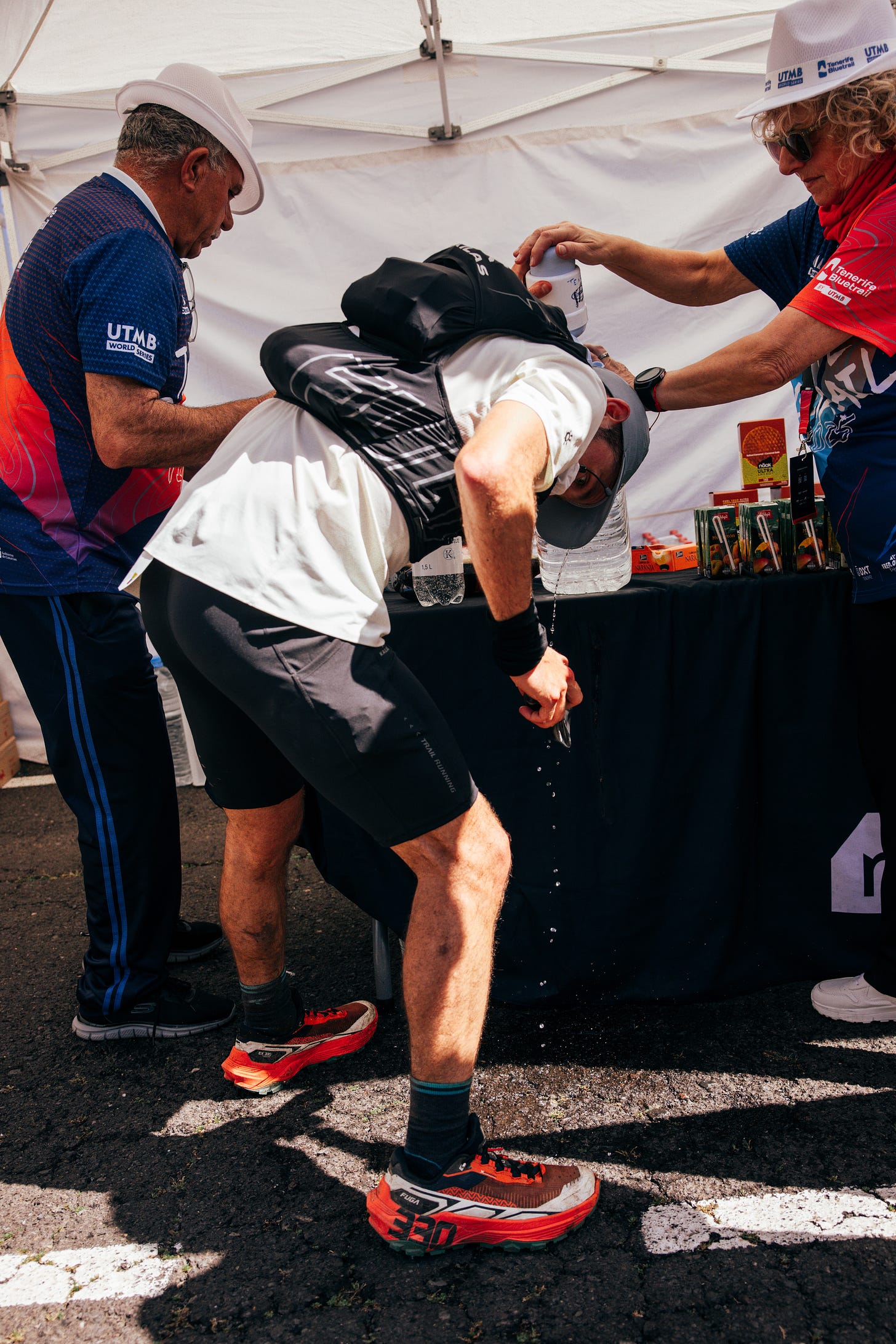Season Opener - Tenerife Bluetrail by UTMB 70km
En español más abajo…
English:
My life went from being in total order and balance between training and work, to exploding overnight with the start of my season and a significant increase in “office work.” So much so that I’ve been wanting to take a minute to write here for weeks… and I haven’t managed to. But here we are! With a recap of my experience at the Tenerife Bluetrail by UTMB 73km. A mix of thoughts and emotions throughout the race.
Why Tenerife? This year I set out to run races that push me out of my comfort zone—ones that really force me to train my weaknesses to become a more complete runner. Tenerife has a course that doesn’t suit me well: 70 km with only 3,000 meters of elevation gain and almost 5,000 meters of descent. My strengths are more aligned with races over 100 km and lots of climbing. But this race fits perfectly into the puzzle of my 2025 season. In my next Substack post, I’ll share how I plan my season and how each race plays a key role in a bigger picture.
I like to check the start list the week before a race. Unlike other runners who go into full blackout mode, I’m motivated by seeing who I’ll be sharing the battlefield with. It helps me visualize the race. Some of the names that gave me chills were: Andrzej Witek, Miguel Heras, Thibaut Garrivier (who ultimately didn’t run due to illness), Philipp Ausserhofer, Jordi Gamito… and the list goes on. It’s impressive how the UTMB World Series is achieving its goal with there isn’t a single race or distance without top-level athletes competing in their races.
I was clear on my goal: Running this race as part of the process of preparation for a bigger 100 mile race. I came with the aim to push myself, see where I’m at, and take some risks, knowing this was just a stepping stone. I wasn’t ruling out the possibility of surprising myself and fighting for the win. I knew Andrzej was in a different league for this distance and course profile, but you never know… In my mind, he could go out fast with Miguel and Thibaut, push the pace, make mistakes… and I could surprise them from the second group in the final stretch.
The race started in Vilaflor at 6:00 a.m., at 1,500 m above sea level. From there, we climbed steadily to 2,530 m. Even though I’m Ecuadorian and grew up at 2,500 m, I’ve now been living in Barcelona—at sea level—for four years, so altitude is no longer an advantage for me.
The race unfolded just as I expected: Andrzej up front with Miguel, and instead of Thibaut, who didn’t run, Tobias Geiser appeared. Behind them, a group of four formed with me in front, followed by Baptiste Petitjean, Marc Ollé, and Jordi Gamito. At one point, just before the summit, I felt that if I stayed there, the race would slip away from me (spoiler: it did). As soon as the terrain flattened a bit, I tried to close the gap to the leaders. I took more risks than I should have, twisted my ankle, and fell. Not only did I gain nothing, but I had to limp for a minute. The group I was leading caught up. I focused, breathed, and remembered the plan I’d worked on with my sports psychologist: “Let them go. Let them make mistakes. I’ll strike at the end.”
We entered the second part of the race: about 25 km all above 2,000 m, with runnable terrain, somewhat rocky, but generally ideal for letting loose and lengthening the stride. Marc, Baptiste, and I pushed each other and kept an excellent pace. That said, the lead group was already out of sight. I’ve worked a lot on my form and stride, and I could feel my body responding much better. But to be honest, I didn’t have much more to give. If the pace increased a bit, I’d have been dropped. Luckily, it didn’t. We arrived together at the aid station at kilometer 43.
Next came a long descent through a misty, humid, and rocky forest. The amazing thing about running in the Canary Islands is that you experience everything—cold, heat, dry, wet. A multitude of microclimates. It’s impossible to get bored.
I was feeling good, sticking to my nutrition plan and my legs were holding up well for the descent. I know descending isn’t my strong suit, but I was focused and flowing. On a more runnable section, I noticed Marc was no longer with us. But Baptiste noticed as well… and in a second, he passed me and doubled the pace. I “slept” on that move—I was in the middle of opening a gel. By the time I finished, it was too late. I accelerated, but never saw him again. The trail was overgrown and full of twists. I started making mistakes: ran into a tree, rolled my ankle, almost fell. My mind turned negative. It was like my “central governor” refused to take more risks. My body wanted to go, but my mind forced me to think: “Just secure a top 5. This is a prep race. It’s not worth the risk.”
I fought those thoughts by talking out loud to myself: “Focus. Let’s go. Here and now. No complaining.” In that inner dispute I reached the base of Asomadero, kilometer 54.
From there, we had a 2.5 km climb with 500 m of elevation gain. This was the section where I had visualized my “attack,” taking advantage of my strengths. I poured water all over myself at the aid station. I started strong, but fatigue hit quickly. This was my first ultra without using poles, and here is where I started to really miss them. I was giving a strong effort, but wasn’t moving fast. Midway up the climb, I heard footsteps and heavy breathing—it was Marc. Immediately I started looking for branches to use as poles. Bingo! One bigger than the other, but they did the trick. I climbed as fast as I could, managed to hold off Marc, but couldn’t catch Baptiste. Then we descended a muddy trail to the Tigaiga checkpoint, kilometer 61.
There, to my surprise, was Tobias, long seen from the lead group at the beginning. The day before, via Instagram, I found volunteers to assist me at that point, the guys from Ongoatmode. It was key. A pit stop like in Formula 1, and I left before Tobias, moving into fourth place. But Marc was right on my heels. From there to the finish, I knew the route well: 10 km of ups and downs through small villages and cliffside trails. But there’s no enjoying the views at that point, enough with staring at the ground and suffering big time.
With 5 km to go, the top three competing for the 50 km race flew past me—among them, my friend Aritz Egea, teammate from Kailas. I latched onto Aritz 'pace as best I could. I don’t know how, but when the body wants, it can. I knew this was my only shot to create a gap and avoid a final sprint with Tobias and Marc. Thanks to that split-second decision to stick with Aritz—the one I didn’t make with Baptiste—I secured fourth place at the finish. To my surprise, just two minutes later came Tobias, Philipp (closing very strong), and Marc. In other words, if I had stopped to adjust my shoe, I would’ve lost three spots. That’s how competitive races are now: six and a half hours of racing and any mistake costs you dearly.
Here the full results
It’s true to say I’m happy with the result, but not satisfied. I think a few years ago, I would’ve been over the moon with this result. On one hand, I’m glad the race played exactly the role I wanted it to: being part of a training block and, above all, finishing injury-free, which allows me to keep training consistently. On the other hand, I had intended to take more risks, to break out of my usual, somewhat conservative race style, and I feel like I didn’t quite accomplish that. I don’t know if it was a lack of confidence, lack of fitness, or both—but the reality is that I wasn’t at the level to contend for the win.
That being said, this fourth place did contribute to keeping that fire burning. I’m just weeks away from my first big goal of the year, and I can’t wait to show myself what I’m capable of.


Español:
Mi vida pasó de estar en total orden y balance entre entrenamiento y trabajo, a explotar de la noche a la mañana con el inicio de mi temporada y un incremento considerable del trabajo “de oficina”. Tanto así que llevo semanas queriendo darme un minuto para escribir aquí… y no lo he conseguido. Pero bueno, ¡aquí estamos! Con un resumen de lo que fue mi paso por la Tenerife BlueTrail by UTMB 73km. Una mezcla de pensamientos y emociones a lo largo de la carrera.
¿Por qué Tenerife? Este año me propuse hacer carreras que me incomoden, que realmente me empujen a entrenar mis debilidades para convertirme en un corredor más completo. Tenerife tiene un perfil poco favorable para mí: en 70 km, apenas 3.000 m de desnivel positivo y casi 5.000 de negativo. Mis fortalezas están más alineadas con carreras de más de 100 km y con mucho desnivel positivo. Pero esta carrera encaja perfectamente en el rompecabezas de mi temporada 2025. En mi próximo Substack contaré cómo planifico la temporada y cómo cada carrera cumple un rol clave dentro de un objetivo más grande.
Me gusta revisar la lista de corredores la semana antes de competir. A diferencia de otros que hacen un “blackout” total en los días previos, a mí me motiva ver con quién voy a compartir la batalla. Me ayuda a visualizar la carrera. Esta vez había nombres que me ponían los pelos de punta: Andrzej Witek, Miguel Heras, Thibaut Garrivier (quien finalmente no corrió por enfermedad), Philipp Ausserhofer, Jordi Gamito… y la lista sigue. Me sorprende cómo el circuito UTMB World Series está logrando su objetivo: no hay carrera ni distancia donde no compitan atletas de primer nivel.
Yo lo tenía claro: esta carrera era parte del proceso, una preparación para algo más grande que se viene pronto en mi especialidad: las 100 millas. Vine con el objetivo de forzarme, ver dónde estoy y arriesgar un poco, sabiendo que era una prueba en mi camino. No descartaba sorprenderme a mí mismo y pelear por la victoria. Sabía que Andrzej está en otra liga para esta distancia y tipo de ruta, pero uno nunca sabe… En mi mente, él podía salir rápido junto a Miguel y Thibaut, presionar, cometer errores… y yo, desde un segundo grupo, sorprender en la parte final.
La carrera arrancó en Vilaflor a las 6:00 a.m., a 1.500 m sobre el nivel del mar. Desde allí subimos hasta los 2.530 m en una subida constante. Aunque soy ecuatoriano y crecí a 2.500 m, ya llevo cuatro años viviendo en Barcelona, al nivel del mar, y la altura ha dejado de ser una ventaja para mí.
La carrera comenzó como lo esperaba: Andrzej al frente con Miguel, y en lugar de Thibaut, que no corrió, apareció Tobias Geiser. Atrás formamos un grupo de cuatro liderado por mí, con Baptiste Petitjean, Marc Ollé y Jordi Gamito. En un momento, antes de llegar al tope, sentí que si me quedaba ahí, la carrera se me escaparía (spoiler: así fue). En cuanto el terreno se aplanó un poco, intenté cerrar la brecha con los de adelante. Arriesgué más de lo que debía, me doblé el tobillo y me caí. No solo no gané nada, sino que tuve que caminar cojeando durante un minuto. El grupo con el que venía me alcanzó enseguida. Me centré, respiré, y recordé el plan trabajado con mi psicóloga deportiva: “Déjalos ir, que cometan errores. Yo sorprenderé al final.”
Entramos a la segunda parte de la carrera: unos 25 km sobre los 2.000 m, con terreno corrible, algo rocoso, pero en general ideal para soltar los frenos y alargar zancada. Con Marc y Baptiste nos presionamos y mantuvimos un ritmo excelente. Eso sí, el grupo de adelante ya estaba fuera de vista. He trabajado mucho mi técnica y mi zancada, y pude sentir que mi cuerpo respondía mucho mejor. Aunque, siendo sincero, no tenía mucho más. Si el ritmo subía un poco, me quedaba. Por suerte, eso no pasó. Llegamos juntos al control del kilómetro 43.
Lo que venía era una bajada larga, dentro de un bosque nublado, húmedo y rocoso. Lo increíble de correr en las islas Canarias es que vives de todo: frío, calor, seco, mojado. Un sinfín de microclimas. Es imposible aburrirse.
Me sentía bien, ejecutando la nutrición al pie de la letra y con piernas para bajar. Sé que bajar no es mi punto fuerte, pero iba concentrado, fluyendo. En una parte más corrible de la bajada, noté que Marc ya no estaba con nosotros. Pero Baptiste sí lo notó… y en un segundo, me pasó y duplicó el ritmo. Me quedé “dormido” en su reacción, justo estaba abriendo un gel. Para cuando lo terminé, ya era tarde. Aunque aceleré, no lo volví a ver. El sendero estaba cubierto de vegetación y lleno de curvas. Empecé a cometer errores: me golpeé contra un árbol, me doblé el tobillo y casi me caigo. Mi mente se volvió negativa. Fue como si mi “gobernador central” se negara a arriesgar más. Mi cuerpo quería, pero la lógica me decía: “Mejor asegura un top 5. Es una carrera de preparación. No vale la pena arriesgar”.
Luchaba con esos pensamientos hablándome en voz alta: “Concéntrate. Vamos. Aquí y ahora. Nada de quejas.” Así llegué a la base del Asomadero, kilómetro 54.
Desde ahí, quedaba una subida de 2,5 km con 500 m de desnivel positivo. Era el lugar donde había visualizado mi “ataque”, aprovechando mis fortalezas. Me duché con agua del abastecimiento, como para resetear la mente. Empecé fuerte, pero pronto noté el cansancio. Este fue mi primer ultra sin bastones, y ahí empecé a extrañarlos. Lo di todo, pero no avanzaba tan rápido. A mitad de subida, escuché pasos y respiración fuerte: era Marc. Empecé a buscar ramas. ¡Bingo! Dos, una más grande que la otra, pero servían. Subí con todo, logré que Marc no me pasara, pero tampoco alcancé a Baptiste. Luego bajamos un sendero lodoso hasta el punto de Tigaiga, kilómetro 61.
Allí, para mi sorpresa, estaba Tobias, del grupo de punta. Un día antes, por Instagram, conseguí voluntarios para asistirme en ese punto, los cracks de Ongoatmode. Fue clave. Un pit stop tipo F1 y salí antes que Tobias, colocándome cuarto. Pero Marc venía pegado. De ahí a meta, conocía bien la ruta: 10 km de sube y baja entre caseríos y senderos al borde de peñascos. Eso sí, poco se puede disfrutar del paisaje en momentos así. Solo puedes mirar al suelo y sufrir.
A 5 km de meta, me pasaron volando los tres primeros de la carrera de 50 km, entre ellos mi amigo Aritz Egea, compañero del equipo Kailas. Me pegué a su ritmo como pude. No sé cómo, pero el cuerpo cuando quiere, puede. Sabía que esa era mi única chance de sacar una ventaja y evitar un sprint final. Gracias a esa decisión inmediata —la que no tomé con Baptiste— aseguré el cuarto lugar en meta. Para mi sorpresa, dos minutos después llegaron Tobias, Philipp (cerrando muy fuerte) y Marc. Es decir, si paraba a ajustarme el zapato, perdía tres puestos. Así de competitivas son las carreras hoy: seis horas y media de esfuerzo, y cualquier error cuesta carísimo. Resultados completos aquí
Es normal y está bien decir que estoy contento con el resultado, pero no satisfecho. Creo que, hace algunos años, hubiera estado en las nubes con este resultado. Por un lado, me alegra que la carrera haya cumplido exactamente el papel que buscaba: ser parte de un bloque de entrenamiento y, sobre todo, terminarla sin lesiones, lo que me permite seguir entrenando con continuidad. Por otro lado, tenía la intención de arriesgar más, de salirme de mi forma “habitual” y algo conservadora de competir, y en parte siento que no lo logré. No sé si fue por falta de confianza, por falta de entrenamiento, o por ambas, pero la realidad es que no estuve al nivel de competir por ganar la carrera.
Lo que sí logró este cuarto lugar es mantener la llama encendida. Estoy a pocas semanas de mi primer gran objetivo del año, y no puedo esperar para demostrarme a mí mismo de lo que soy capaz.
Aquí pueden ver el vídeo que me hicieron de Ongoatmode pre carrera:





